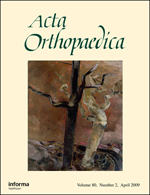
ARTHROPLASTY
TKA: Postoperative opiate use lowered by intraoperative periarticular LIA
This report has been verified
by one or more authors of the
original publication.
Acta Orthop. 2014 Dec;85(6):614-9.
60 patients undergoing primary total knee arthroplasty were randomized to receive either a periarticular local infiltration analgesia (LIA) with levobupivacaine, ketorolac, and adrenaline versus a placebo injection of saline. Oxycodone consumption, pain, and range of motion were measured over 48 hours postoperatively, and functional outcomes were evaluated 1 year following surgery. The results of this study suggest that LIA reduced cumulative oxycodone consumption over the first 24 postoperative hours, with effect mainly occurring within the first 6 hours after surgery. Knee range of motion was also greater at 6 hours in those who received LIA, though no significant differences were detected at 24 and 48h. Functional outcomes were similar between groups at 1 year.
Unlock the full ACE Report
You have access to {0} free articles per month.Click below to unlock and view this {1}
Unlock NowCritical appraisals of the latest, high-impact randomized controlled trials and systematic reviews in orthopaedics
Access to OrthoEvidence podcast content, including collaborations with the Journal of Bone and Joint Surgery, interviews with internationally recognized surgeons, and roundtable discussions on orthopaedic news and topics
Subscription to The Pulse, a twice-weekly evidence-based newsletter designed to help you make better clinical decisions
Exclusive access to original content articles, including in-house systematic reviews, and articles on health research methods and hot orthopaedic topics
Or upgrade today and gain access to all OrthoEvidence content for just $1.99 per week.
Already have an account? Log in


Subscribe to "The Pulse"
Evidence-Based Orthopaedics direct to your inbox.
{0} of {1} free articles
Become an OrthoEvidence Premium Member. Expand your perspective with high-quality evidence.
Upgrade Now













































































